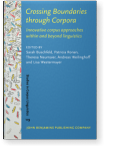Chapter 7
Syntactic segmentation of spoken corpus data
What prosody can contribute
Most corpus-based syntactic segmentation schemes rely on transcriptions alone, which can lead to segmentation difficulties, especially when analyzing spontaneous conversations. We therefore suggest an approach to segmentation that complements syntactic segmentation techniques with prosodic analyses and describe correspondences in syntactic and prosodic segmentation as well as the exact syntactic contexts in which prosodic analyses are necessary to avoid ambiguities and potential inaccuracies. Using 10 recordings from the Louvain Corpus of Native English Conversation, utterances are independently and manually segmented and annotated for various linguistic variables. While the results of our analyses indicate a considerable overlap of intermediate phrases and clausal units, we also showcase syntactic contexts where prosody is needed for disambiguation (e.g. monologs, discourse markers, dysfluencies, and adverbials).
Article outline
- 1.Introduction
- 2.Syntactic vs. prosodic units and analyses
- 2.1Comparing basic concepts and definitions
- 2.2Comparing syntactic and prosodic structures of speech
- 2.3Approaches to analyses at the syntax-prosody interface
- 3.Database and methodology
- 3.1Corpus
- 3.2Prosodic segmentation
- 3.3Syntactic segmentation
- 4.Results
- 4.1Correspondence of intonation units and syntactic units
- 4.2Lengths of intonation units and syntactic units
- 4.3Analyzing the necessity of prosody for syntactic segmentation
- 5.Discussion
- 6.Conclusion
-
Notes
-
References
-
Appendix
This content is being prepared for publication; it may be subject to changes.
